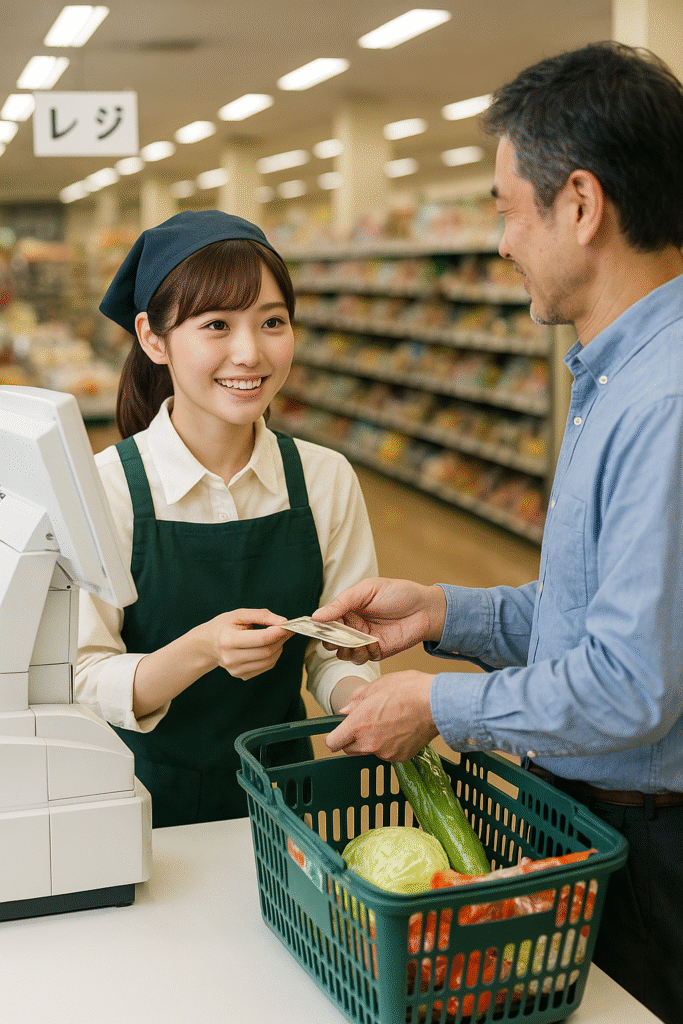
Shopping in a Japanese supermarket can be a fun, eye-opening experience. From seasonal fruits to regional snacks, Japanese supermarkets offer a glimpse into everyday life. But for first-time visitors, the experience can be a bit confusing due to differences in layout, customs, and language.
This detailed guide will walk you through everything from entering the store to checking out—including how to use self-checkout and what to watch for in cultural etiquette.
🛒 Step 1: Grab a Basket or Cart
- Upon entering, take a shopping basket—they’re usually stacked near the entrance.
- You can place the basket into a rolling cart frame to make it easier to move around.
- Some larger stores may offer full-size carts, but baskets are more common.
🌿 Step 2: Browse the Aisles
- Items are grouped by type, often in this order:
- Produce (fruits, vegetables)
- Fresh meat and fish
- Refrigerated items (tofu, dairy)
- Packaged foods (rice, noodles, snacks)
- Condiments and sauces
- Household items and toiletries
- Fresh produce may be sold individually, not by weight. Prices are per piece unless otherwise marked.
- Look out for unfamiliar but interesting items like seasonal fruits, regional miso, or Japanese sweets (wagashi).
🔤 Tip: Use Google Lens or Google Translate app to scan labels in real time.
📉 Step 3: Check for Discounts
- Supermarkets commonly mark down fresh and prepared foods as the day goes on.
- Look for yellow, red, or orange stickers—they indicate discounts (usually 10–50%).
- The best time for deals is typically after 6 PM, especially for bento and sushi packs.
🧺 Step 4: Go to Checkout
You’ll usually find two types of checkout:
🧑💼 Option A: Staffed Checkout (有人レジ)
- Hand your basket to the cashier—they’ll scan items and place them in another empty basket.
- Payment options usually include:
- Cash (¥1,000 and coins are handy)
- IC Cards (Suica, Pasmo)
- Credit cards (Visa, MasterCard, JCB)
- After payment, head to the bagging counter to pack your items.
- Plastic bags are not free—they cost ¥2–5, so bring a reusable bag if you can.
🔄 Option B: Self-Checkout (セルフレジ)
- Becoming increasingly popular in urban areas.
- Steps:
- Scan your items one at a time.
- Press the language button (English is often available).
- Choose your payment method.
- Pack your own items afterward.
⚠️ If using an IC card, make sure the machine supports it. Some only take cash.
🧾 Receipts and Points
- Many stores offer loyalty cards. If you’re staying long-term, ask at the counter.
- Receipts often include the tax breakdown (8% for food, 10% for household items).
🏪 Other Useful Notes
- No tipping is needed—service is included.
- Some stores offer an eat-in space near the front with microwaves and hot water.
- Toiletries, cleaning products, and household goods are usually in a separate section.
- Supermarkets often share space with 100-yen shops or drugstores.
🗑️ Recycling & Etiquette
- Use provided bins to dispose of plastic bottles and cans.
- Don’t eat while walking through the aisles.
- Keep aisles clear and be mindful of your cart.